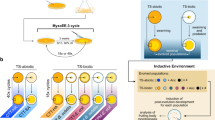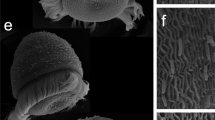Abstract
In an attempt to understand the significance of predation in the evolution of prey species, the ecological and morphological characteristics of bacterial species under predation by a ciliated protozoa,Cyclidium sp., were investigated. Serial transfer at 7 day intervals was applied to the bacterial populations in the presence or absence ofCyclidium. Although cells of the parental bacterial strain are typically short rods up to 1.5 μm long, cells of much greater length, up to 20 μm long (type L) were found in populations exposed to predation fromCyclidium. However, the wildtype, shorter length bacteria persisted even after the appearance of type L. Type L was not observed in the singl bacterial culture throughout the serial transfers. Type L appeared to improve the ability to escape predation by elongating cell size, but growth rate and saturation density were decreased.
Similar content being viewed by others
References
Abrams PA (1986) Is predator-prey coevolution an arms race? Tree 1:108–110
Appleton RD, Palmer AR (1988) Water-borne stimuli released by predatory crabs and damaged prey induced more predator-resistant shells in a marine gastropod. Proc Natl Acad Sci USA 85:4387–4391
Chao L., Levin BR, Stewart FM (1977) A complex community in a simple habitat: An experimental study with bacteria and phage. Ecology 58:369–379
Dodson SI (1989) The ecological role of chemical stimuli for the zooplankton: Predator-induced morphology inDaphnia. Oecologia 78:361–367
Gilbert JJ, Stemberger RS (1984)Asplanchna-induced polymorphism in the rotiferKeratella slacki. Limnol Oceanogr 29:1309–1316
Harvell CD (1986) The ecology and evolution of inducible defenses in a marine bryozoan: Cues, costs, and consequences, Am Nat 128:810–820
Hassell MP, Huffaker C (1969) Regulatory processes and population cyclicity in laboratory populations ofAnagasta kühniella (Zeller) (Lepidoptera: Phycitidae). III. Development of population models. Res Pop Ecol 11:186–210
Horne MT (1970) Coevolution ofEscherichia coli and bacteriophage in chemostat culture. Science 168:992–993
Kurihara Y (1978) Studies of the interaction in a microcosm. Sci Rep Tohoku Univ 37:161–177
Lenski RE, Levin BR (1985) Constraints on the coevolution of bacteria and virulent phage: A model, some experiments, and predictions for natural communities. Am Nat 125:585–602
Normark S, Boman HG, Matsson E (1969) Mutant ofEscherichia coli with anomalous cell division and ability to decrease episomally and chromosomally mediated resistance to ampicillin and several other antibiotics. J Bacteriol 97:1334–1342
Pimentel D, Stone FA (1968) Evolution and population ecology of parasite-host systems, Can Ent 100:655–662
Taub FB, Dollar AM (1964) AChlorella-Daphnia food-chain study; the design of a compatible chemically defined culture medium. Limnol Oceanogr 9:61–74
Author information
Authors and Affiliations
Rights and permissions
About this article
Cite this article
Shikano, S., Luckinbill, L.S. & Kurihara, Y. Changes of traits in a bacterial population associated with protozoal predation. Microb Ecol 20, 75–84 (1990). https://doi.org/10.1007/BF02543868
Received:
Revised:
Issue Date:
DOI: https://doi.org/10.1007/BF02543868




